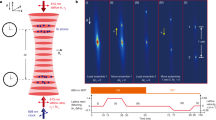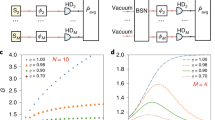Abstract
Optical atomic clocks are our most precise tools to measure time and frequency1,2,3. Precision frequency comparisons between clocks in separate locations enable one to probe the space–time variation of fundamental constants4,5 and the properties of dark matter6,7, to perform geodesy8,9,10 and to evaluate systematic clock shifts. Measurements on independent systems are limited by the standard quantum limit; measurements on entangled systems can surpass the standard quantum limit to reach the ultimate precision allowed by quantum theory—the Heisenberg limit. Although local entangling operations have demonstrated this enhancement at microscopic distances11,12,13,14,15,16, comparisons between remote atomic clocks require the rapid generation of high-fidelity entanglement between systems that have no intrinsic interactions. Here we report the use of a photonic link17,18 to entangle two 88Sr+ ions separated by a macroscopic distance19 (approximately 2 m) to demonstrate an elementary quantum network of entangled optical clocks. For frequency comparisons between the ions, we find that entanglement reduces the measurement uncertainty by nearly \(\sqrt{2}\), the value predicted for the Heisenberg limit. Today’s optical clocks are typically limited by dephasing of the probe laser20; in this regime, we find that entanglement yields a factor of 2 reduction in the measurement uncertainty compared with conventional correlation spectroscopy techniques20,21,22. We demonstrate this enhancement for the measurement of a frequency shift applied to one of the clocks. This two-node network could be extended to additional nodes23, to other species of trapped particles or—through local operations—to larger entangled systems.
This is a preview of subscription content, access via your institution
Access options
Access Nature and 54 other Nature Portfolio journals
Get Nature+, our best-value online-access subscription
$29.99 / 30 days
cancel any time
Subscribe to this journal
Receive 51 print issues and online access
$199.00 per year
only $3.90 per issue
Buy this article
- Purchase on Springer Link
- Instant access to full article PDF
Prices may be subject to local taxes which are calculated during checkout




Similar content being viewed by others
Data availability
Source data for all plots are available. All other data or analysis code that support the plots are available from the corresponding authors upon reasonable request.
References
Brewer, S. M. et al. 27Al+ quantum-logic clock with a systematic uncertainty below 10−18. Phys. Rev. Lett. 123, 033201 (2019).
Oelker, E. et al. Demonstration of 4.8 × 10−17 stability at 1 s for two independent optical clocks. Nat. Photonics 13, 714–719 (2019).
Ludlow, A. D., Boyd, M. M., Ye, J., Peik, E. & Schmidt, P. O. Optical atomic clocks. Rev. Mod. Phys. 87, 637 (2015).
Rosenband, T. et al. Frequency ratio of Al+ and Hg+ single-ion optical clocks; metrology at the 17th decimal place. Science 319, 1808–1812 (2008).
Lange, R. et al. Improved limits for violations of local position invariance from atomic clock comparisons. Phys. Rev. Lett. 126, 011102 (2021).
Derevianko, A. & Pospelov, M. Hunting for topological dark matter with atomic clocks. Nat. Phys. 10, 933–936 (2014).
Safronova, M. S. et al. Search for new physics with atoms and molecules. Rev. Mod. Phys. 90, 025008 (2018).
Chou, C.-W., Hume, D. B., Rosenband, T. & Wineland, D. J. Optical clocks and relativity. Science 329, 1630–1633 (2010).
Mehlstäubler, T. E., Grosche, G., Lisdat, C., Schmidt, P. O. & Denker, H. Atomic clocks for geodesy. Rep. Prog. Phys. 81, 064401 (2018).
McGrew, W. et al. Atomic clock performance enabling geodesy below the centimetre level. Nature 564, 87–90 (2018).
Meyer, V. et al. Experimental demonstration of entanglement-enhanced rotation angle estimation using trapped ions. Phys. Rev. Lett. 86, 5870–5873 (2001).
Leibfried, D. et al. Toward Heisenberg-limited spectroscopy with multiparticle entangled states. Science 304, 1476–1478 (2004).
Roos, C. F., Chwalla, M., Kim, K., Riebe, M. & Blatt, R. ‘Designer atoms’ for quantum metrology. Nature 443, 316–319 (2006).
Megidish, E., Broz, J., Greene, N. & Häffner, H. Improved test of local Lorentz invariance from a deterministic preparation of entangled states. Phys. Rev. Lett. 122, 123605 (2019).
Manovitz, T., Shaniv, R., Shapira, Y., Ozeri, R. & Akerman, N. Precision measurement of atomic isotope shifts using a two-isotope entangled state. Phys. Rev. Lett. 123, 203001 (2019).
Pedrozo-Peñafiel, E. et al. Entanglement on an optical atomic-clock transition. Nature 588, 414–418 (2020).
Moehring, D. L. et al. Entanglement of single-atom quantum bits at a distance. Nature 449, 68–71 (2007).
Monroe, C. et al. Large-scale modular quantum-computer architecture with atomic memory and photonic interconnects. Phys. Rev. A 89, 022317 (2014).
Stephenson, L. J. et al. High-rate, high-fidelity entanglement of qubits across an elementary quantum network. Phys. Rev. Lett. 124, 110501 (2020).
Clements, E. R. et al. Lifetime-limited interrogation of two independent 27Al+ clocks using correlation spectroscopy. Phys. Rev. Lett. 125, 243602 (2020).
Hume, D. B. & Leibrandt, D. R. Probing beyond the laser coherence time in optical clock comparisons. Phys. Rev. A 93, 032138 (2016).
Kim, M. E. et al. Optical coherence between atomic species at the second scale: improved clock comparisons via differential spectroscopy. Preprint at https://arxiv.org/abs/2109.09540 (2021).
Komar, P. et al. A quantum network of clocks. Nat. Phys. 10, 582–587 (2014).
Wineland, D. J., Bollinger, J. J., Itano, W. M., Moore, F. & Heinzen, D. J. Spin squeezing and reduced quantum noise in spectroscopy. Phys. Rev. A 46, R6797 (1992).
Wineland, D. J., Bollinger, J. J., Itano, W. M. & Heinzen, D. Squeezed atomic states and projection noise in spectroscopy. Phys. Rev. A 50, 67 (1994).
Degen, C. L., Reinhard, F. & Cappellaro, P. Quantum sensing. Rev. Mod. Phys. 89, 035002 (2017).
Pezzè, L., Smerzi, A., Oberthaler, M. K., Schmied, R. & Treutlein, P. Quantum metrology with nonclassical states of atomic ensembles. Rev. Mod. Phys. 90, 035005 (2018).
Caves, C. M. Quantum-mechanical noise in an interferometer. Phys. Rev. D 23, 1693 (1981).
Tse, M. et al. Quantum-enhanced advanced LIGO detectors in the era of gravitational-wave astronomy. Phys. Rev. Lett. 123, 231107 (2019).
Malnou, M. et al. Squeezed vacuum used to accelerate the search for a weak classical signal. Phys. Rev. X 9, 021023 (2019).
Wolf, F. et al. Motional Fock states for quantum-enhanced amplitude and phase measurements with trapped ions. Nat. Commun. 10, 2929(2019).
Gilmore, K. A. et al. Quantum-enhanced sensing of displacements and electric fields with two-dimensional trapped-ion crystals. Science 373, 673–678 (2021).
Kimble, H. J. The quantum internet. Nature 453, 1023–1030 (2008).
Gisin, N., Ribordy, G., Tittel, W. & Zbinden, H. Quantum cryptography. Rev. Mod. Phys. 74, 145–195 (2002).
Monroe, C. & Kim, J. Scaling the ion trap quantum processor. Science 339, 1164–1169 (2013).
Hensen, B. et al. Loophole-free Bell inequality violation using electron spins separated by 1.3 kilometres. Nature 526, 682–686 (2015).
Ramsey, N. F. A molecular beam resonance method with separated oscillating fields. Phys. Rev. 78, 695–699 (1950).
Ramsey, N. F. Resonance experiments in successive oscillatory fields. Rev. Sci. Instrum. 28, 57–58 (1957).
Itano, W. M. et al. Quantum projection noise: population fluctuations in two-level systems. Phys. Rev. A 47, 3554 (1993).
Giovannetti, V., Lloyd, S. & Maccone, L. Quantum metrology. Phys. Rev. Lett. 96, 010401 (2006).
Riis, E. & Sinclair, A. G. Optimum measurement strategies for trapped ion optical frequency standards. J. Phys. B 37, 4719–4732 (2004).
Leroux, I. D. et al. On-line estimation of local oscillator noise and optimisation of servo parameters in atomic clocks. Metrologia 54, 307–321 (2017).
Bize, S. et al. Interrogation oscillator noise rejection in the comparison of atomic fountains. IEEE Trans. Ultrason. Ferroelectr. Freq. Control 47, 1253–1255 (2000).
Chwalla, M. et al. Precision spectroscopy with two correlated atoms. Appl. Phys. B 89, 483–488 (2007).
Marti, G. E. et al. Imaging optical frequencies with 100 μHz precision and 1.1 μm resolution. Phys. Rev. Lett. 120, 103201 (2018).
Young, A. W. et al. Half-minute-scale atomic coherence and high relative stability in a tweezer clock. Nature 588, 408–413 (2020).
Nadlinger, D. P. et al. Experimental quantum key distribution certified by Bell's theorem. Nature 607, 682–686 (2022).
Stephenson, L. Entanglement between Nodes of a Quantum Network. Ph.D. thesis, Univ. of Oxford (2019).
Sahoo, B. K., Islam, M. R., Das, B. P., Chaudhuri, R. K. & Mukherjee, D. Lifetimes of the metastable 2D3/2,5/2 states in Ca+, Sr+, and Ba+. Phys. Rev. A 74, 062504 (2006).
Gabrielse, G. & Tan, J. Self-shielding superconducting solenoid systems. J. Appl. Phys 63, 5143–5148 (1988).
Ruster, T. et al. A long-lived Zeeman trapped-ion qubit. Appl. Phys. B 122, 254 (2016).
Aharon, N., Spethmann, N., Leroux, I. D., Schmidt, P. O. & Retzker, A. Robust optical clock transitions in trapped ions using dynamical decoupling. New J. Phys. 21, 083040 (2019).
Schmidt, P. O. et al. Spectroscopy using quantum logic. Science 309, 749–752 (2005).
Hughes, A. C. et al. Benchmarking a high-fidelity mixed-species entangling gate. Phys. Rev. Lett. 125, 080504 (2020).
Boulder Atomic Clock Optical Network (BACON) Collaboration. Frequency ratio measurements at 18-digit accuracy using an optical clock network. Nature 591, 564–569 (2021).
Wright, T. A. et al. Two-way photonic interface for linking the Sr+ transition at 422 nm to the telecommunication C band. Phys. Rev. App. 10, 044012 (2018).
Acknowledgements
We thank E. R. Clements, R. M. Godun, D. B. Hume and A. M. Steane for helpful discussions and insightful comments on the manuscript. We thank Sandia National Laboratories for supplying the HOA2 ion traps used in these experiments. This work was supported by the UK EPSRC Hub in Quantum Computing and Simulation (EP/T001062/1), the EU Quantum Technology Flagship Project AQTION (No. 820495) and C.J.B.’s UKRI Fellowship (MR/S03238X/1). B.C.N. acknowledges funding from the UK National Physical Laboratory.
Author information
Authors and Affiliations
Contributions
D.P.N., B.C.N., P.D., D.M., G.A., R.S. and C.J.B. built and maintained the experimental apparatus. R.S. conceived the experiments. B.C.N. and R.S. carried out the experiments, assisted by D.P.N., P.D., D.M. and G.A. B.C.N., R.S. and D.M.L. analysed the data. B.C.N. and R.S. wrote the manuscript with input from all authors. C.J.B. and D.M.L. secured funding and supervised the work.
Corresponding authors
Ethics declarations
Competing interests
C.J.B. is a director of Oxford Ionics. The remaining authors declare no competing interests.
Peer review
Peer review information
Nature thanks David Leibrandt and the other, anonymous, reviewer(s) for their contribution to the peer review of this work. Peer reviewer reports are available.
Additional information
Publisher’s note Springer Nature remains neutral with regard to jurisdictional claims in published maps and institutional affiliations.
Supplementary information
Supplementary Information
Supplementary Sections A–J, including Figs. S1–9.
Rights and permissions
Springer Nature or its licensor holds exclusive rights to this article under a publishing agreement with the author(s) or other rightsholder(s); author self-archiving of the accepted manuscript version of this article is solely governed by the terms of such publishing agreement and applicable law.
About this article
Cite this article
Nichol, B.C., Srinivas, R., Nadlinger, D.P. et al. An elementary quantum network of entangled optical atomic clocks. Nature 609, 689–694 (2022). https://doi.org/10.1038/s41586-022-05088-z
Received:
Accepted:
Published:
Issue Date:
DOI: https://doi.org/10.1038/s41586-022-05088-z
This article is cited by
-
Direct comparison of two spin-squeezed optical clock ensembles at the 10−17 level
Nature Physics (2024)
-
Quantum sensing for particle physics
Nature Reviews Physics (2024)
-
Widely tunable and narrow-linewidth chip-scale lasers from near-ultraviolet to near-infrared wavelengths
Nature Photonics (2023)
-
Quantum networks with neutral atom processing nodes
npj Quantum Information (2023)
-
Distributed quantum sensing with mode-entangled spin-squeezed atomic states
Nature (2022)
Comments
By submitting a comment you agree to abide by our Terms and Community Guidelines. If you find something abusive or that does not comply with our terms or guidelines please flag it as inappropriate.



